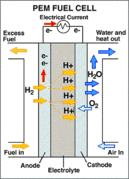Grubb, Willard Thomas
Willard Thomas Grubb, while working for General Electric (GE) in Schenectady, New York as a chemist, made a major advance in fuel cells, originally designed by Sir William Grove in 1839. Grubb developed the sulphonated polystyrene ion-exchange membrane in 1955; it is now referred to as the Proton Exchange Membrane, or PEM fuel cell. Three years later, another GE chemist, Leonard Niedrach, devised a way of depositing platinum onto this membrane. The improvements made through the combined efforts of Grubb and Niedrach ultimately produced the "Grubb-Niedrach fuel cell". GE and the National Aeronautics and Space Administration (NASA) developed this technology together, using the fuel cell in the Gemini space project, one of the first commercial uses of a fuel cell.
Further Reading
Fuel Cell Basics (U. S. Department of Defense, Fuel Cell Test and Evaluation Center)
History of Fuel Cells (Smithsonian Institute, National Museum of American History)
Types of Fuel Cells (U. S. Department of Energy, Office of Energy Efficiency and Renewable Energy)
